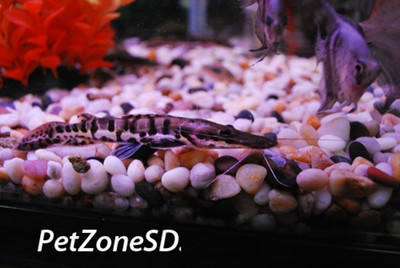Tiger Shovelnose Catfish
Posted by Max Gandara on on 28th May 2025
Tiger Shovelnose Catfish: The Majestic Predator of Freshwater Aquariums
If you’re looking to add a striking and powerful centerpiece fish to your large freshwater aquarium, the Tiger Shovelnose Catfish (Pseudoplatystoma fasciatum) is an incredible choice. Known for its bold tiger-like stripes and unique shovel-shaped snout, this species combines fierce beauty with interesting behavior, making it a favorite among advanced aquarists.
What is the Tiger Shovelnose Catfish?
Native to the river basins of South America, especially the Amazon and Orinoco, the Tiger Shovelnose Catfish is a large predatory species that can grow up to 36 inches (90 cm) or more in captivity. Its distinctive elongated head and broad flat snout give it a unique appearance, while the black and yellow/tan striped pattern resembles a tiger’s coat — hence its common name.
Despite its fierce look, the Tiger Shovelnose Catfish is known for its intelligence and responsiveness, often recognizing their keepers and displaying curious behavior.
Why Choose a Tiger Shovelnose Catfish?
-
Striking Appearance: Bold tiger-like stripes and a distinctive shovel-shaped head make it a true standout in large aquariums.
-
Impressive Size: Reaches large adult sizes, becoming a true centerpiece fish.
-
Intelligent and Interactive: Known to respond to feeding times and may even be hand-fed by experienced keepers.
-
Predatory but Social: While carnivorous, they can be housed with other large, non-aggressive fish.
Tank Requirements
Due to their size and activity level, Tiger Shovelnose Catfish require ample space and excellent water quality:
-
Tank Size: Minimum 180 gallons (681 liters) or more, depending on adult size. Larger is always better.
-
Water Temperature: 75–82°F (24–28°C).
-
pH: Slightly acidic to neutral, 6.5–7.5.
-
Filtration: Powerful filtration to handle high bioload and maintain pristine water conditions.
-
Decor: Provide plenty of open swimming space with some driftwood or sturdy rocks for hiding spots.
Feeding and Diet
Tiger Shovelnose Catfish are carnivores with a strong appetite:
-
Feed a varied diet of live or frozen meaty foods such as fish fillets, shrimp, worms, and occasionally feeder fish (use caution with live feeders to avoid disease).
-
Can be trained to accept high-quality pellets formulated for carnivorous fish.
-
Feed 2–3 times per week, adjusting portion size as the fish grows.
Behavior and Tankmates
-
They are generally peaceful with other large fish but will eat smaller fish and tankmates that fit in their mouth.
-
Ideal tankmates include large plecos, large cichlids, and other robust fish that can hold their own.
-
Avoid keeping with tiny or very slow-moving species.
Challenges and Considerations
-
Size: Requires very large tanks and commitment to long-term care.
-
Jumpers: Can be surprisingly agile; secure tank lids are essential.
-
Water Quality: Sensitive to poor water conditions, so regular maintenance is crucial.
-
Aggression: Predatory instincts mean careful choice of tankmates is needed.
Final Thoughts
The Tiger Shovelnose Catfish is a majestic and fascinating fish for dedicated aquarists with the space and experience to care for it properly. Its bold appearance and engaging personality make it a rewarding centerpiece in any large freshwater aquarium.
Thinking of adding a Tiger Shovelnose Catfish to your tank? Be sure to prepare a large, well-filtered aquarium with appropriate tankmates and a nutritious diet for a thriving giant.

